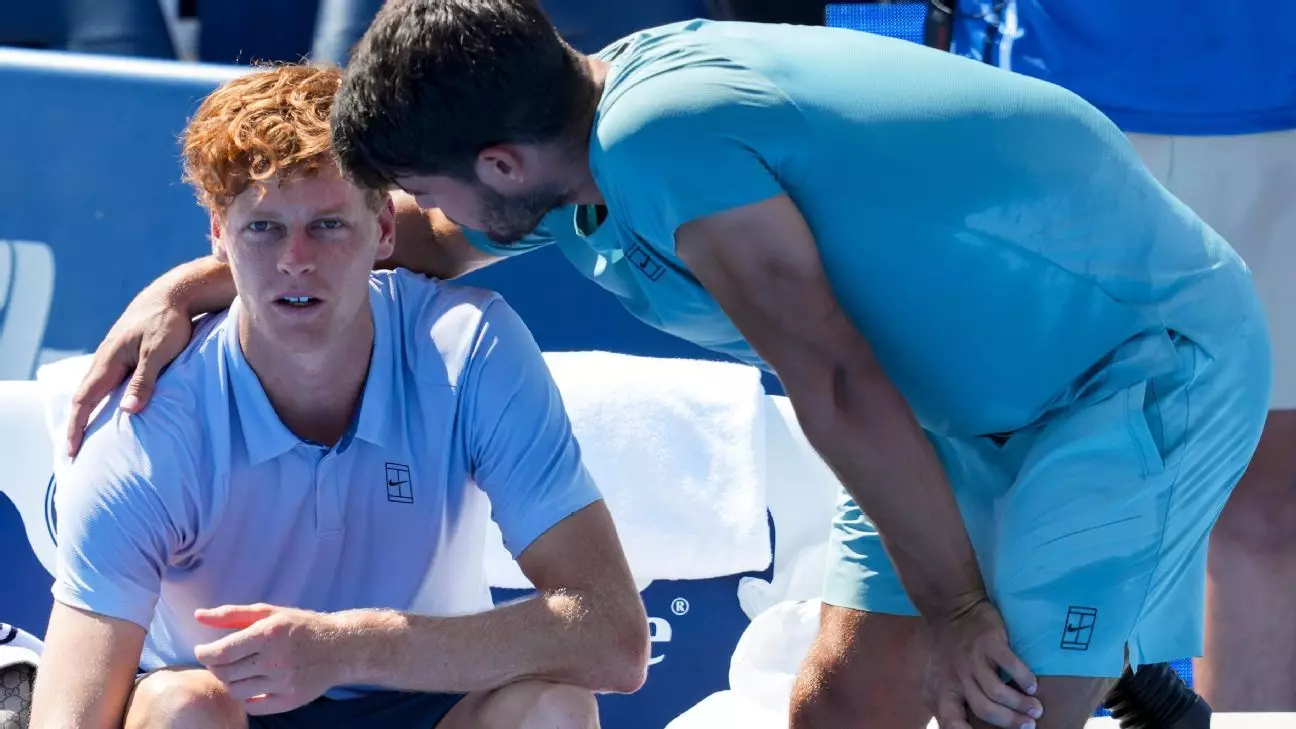The 2023 Cincinnati Open culminated in an unusual yet compelling moment that underscored the unpredictable nature of tennis. Instead of a fiercely contested marathon, viewers were presented with a brief, poignant encounter—Carlos Alcaraz claiming the title after Jannik Sinner was forced to retire due to illness. While some might dismiss this as a negligible victory, it actually highlights the often-overlooked emotional and physical toll top-tier athletes endure. Alcaraz’s triumph, obtained in just 22 minutes, is not merely a statistic; it accentuates his resilience despite the abrupt conclusion. Sinner’s early departure, feeling unwell during a crucial phase, reveals that even the most competitive athletes are vulnerable—not invincible entities, but humans subject to their physical limits.
From a broader perspective, this incident serves as a somber reminder that dominance in tennis isn’t solely measured by scorelines or titles won but also by the capacity to withstand adversity, whether injury, illness, or unexpected setbacks. Alcaraz, having expressed genuine concern for Sinner’s recovery, demonstrates sportsmanship that elevates him beyond the mere competitor. The match’s swift end, though disappointing for spectators craving a fierce contest, subtly underlines the reality that health is the foundation of sustained excellence in tennis.
The Significance of a Surreal Victory
In the realm of professional tennis, titles usually come after long, grueling battles that test endurance, skill, and mental toughness. Alcaraz’s win here might seem insignificant superficially—an easy, almost anticlimactic victory. But when delving deeper, it symbolizes a pivotal milestone for the emerging star. Having previously lost in Cincinnati last year, Alcaraz was eager to capture the trophy, and this incident provides a chance to reflect on his perseverance and growing dominance on hard courts.
The victory signals that Alcaraz’s confidence is not merely built on physical prowess but also on mental resilience. Despite the unusual circumstances, he maintained composure, publicly expressing well wishes for Sinner’s recovery, showcasing maturity that complements his rising talent. His 9-5 edge over Sinner historically indicates a competitive rivalry that is only going to intensify, especially as both athletes approach their primes with different but intersecting paths. More than a psychological lift, this win reinforces Alcaraz’s claim as the future face of men’s tennis, particularly on hard courts where his agility and shot-making continue to impress.
Contrasts and Comparisons: A Changing Tennis Landscape
Historically, Cincinnati’s finals have been arenas of fierce rivalry and peak performances, with notable retirements adding an extra chapter to the tournament’s storied history. The fact that this was only the third time a Cincinnati final ended prematurely underscores how rare and exceptional such circumstances are. The last instance, involving Djokovic’s shoulder injury in 2011, reminds us that physical issues can strike at the most inopportune moments, shifting the narrative from sporting excellence to human frailty.
This particular final also highlights how the sport is evolving. The dominance of players like Federer, Djokovic, and Nadal once defined the era, but today’s landscape is witnessing a generational shift with Alcaraz and Sinner at the forefront. Their encounters have always promised fireworks—until illness and circumstance intervene. Still, Alcaraz’s ascent signals a new chapter where resilience and adaptability might outweigh traditional rivalry battles. It’s a reminder that tennis is as much a mental game as it is physical; the ability to remain focused amid challenges often separates champions from mere competitors.
The Road Ahead and The Unfinished Story
With Alcaraz capturing the Cincinnati title in a highly unusual fashion, the narrative now shifts to the upcoming U.S. Open. Historically, champions here have often carried momentum into Flushing Meadows, elevating their confidence as they chase grand slam glory. Alcaraz, now a contender with even more validated resilience, enters the U.S. Open with momentum—yet also with the hope that his rivals will be healthy and ready to challenge him. His victory, though marred by the circumstances, undoubtedly boosts his position as a top contender.
Sinner’s situation, on the other hand, introduces an element of vulnerability in a game that often celebrates resilience and consistency. His illness serves as a stark reminder that health remains a fundamental pillar for success in tennis. The hope is for him to recover swiftly, and in doing so, restore his full competitive edge.
This tournament’s conclusion may seem anticlimactic, but it symbolically heralds a period of transition and renewal. Tennis, inherently unpredictable, continues to surprise and inspire—reminding us that victory isn’t always about enduring battles or long rallies but sometimes about overcoming the unexpected. As Alcaraz looks toward future tournaments, it’s clear that his trajectory is upward, driven by both talent and mental toughness, qualities that will serve him well in the battles yet to come.

